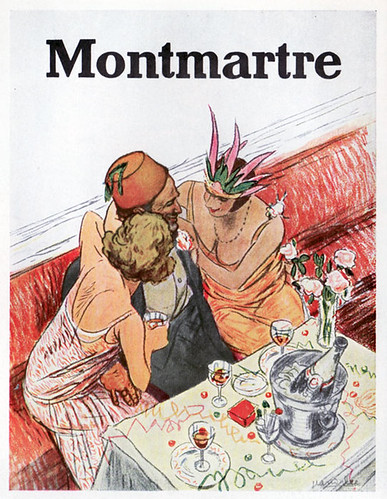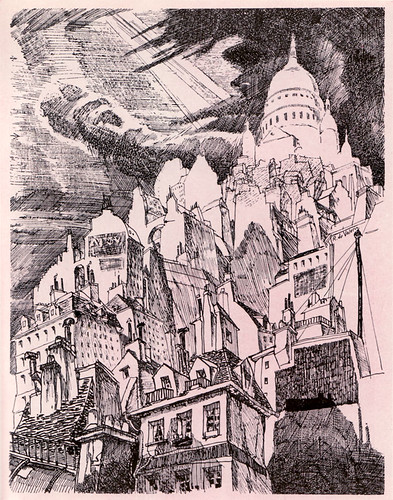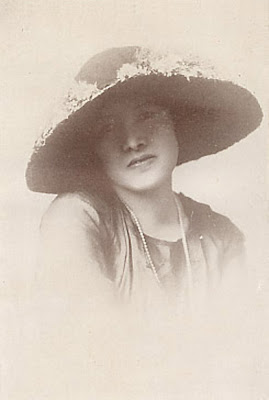Another discovered French Art Deco artist from Kjell Strömberg's nostalgic "Paris i närbild" (1934).
Jean Dulac (1902-1968)
Born in Lyon, France. Worked as a painter, sculptor, and illustrator. Studied at the Beaux-Arts, Paris. As a printmaker, Jean Dulac produced copper engravings, etchings, and pochoirs. For erotic works, Dulac used a pseudonym, Jean de l'Étang.
2008/08/30
La minute heureuse
A l'ombre du Sacre Coeur
In the shadow of Sacre Coeur, drawing by Roger de Valerio (1886-1951).
Petit curriculum vitae d'artiste (because it is almost impossible to find info on the net):Picture from Swedish author Kjell Strömberg's Paris i närbild (1934)
Né à Lille, il fait des études d'architecture aux Beaux-Arts à Paris.
1911-1914 : directeur artistique du journal Le Matin
1917 : Il entre chez l'éditeur de musique Salabert, où, jusqu'en 1924,
il réalise plus de 2 000 couvertures.
1926 : conseiller artistique chez Devambez
1932 :à la tête du journal Le Rire
1936-1940 : directeur associé des Editions Perceval
1933 : Il donne des cours à l'Ecole technique de publicité
1940 : Il se retire à Belle-Île et se consacre à la peinture (nus et fleurs), puis à l'illustration de livre (le Surmâle de Jarry)
2008/08/27
Edith Södergran
En fågel satt fången i en gyllene bur
i ett vitt slott vid ett djupblått hav.
Smäktande rosor lovade vällust och lycka.
Och fågeln sjöng om en liten by högt uppe i bergen,
där solen är konung och tystnaden drottning
och där karga små blommor i lysande färger
vittna om livet, som trotsar och består.
"En fången fågel", ur Dikter (1916)
i ett vitt slott vid ett djupblått hav.
Smäktande rosor lovade vällust och lycka.
Och fågeln sjöng om en liten by högt uppe i bergen,
där solen är konung och tystnaden drottning
och där karga små blommor i lysande färger
vittna om livet, som trotsar och består.
"En fången fågel", ur Dikter (1916)
2008/08/24
The Pomeranian Menace

It is a little-known fact that humanity was entirely at the mercy of small fluffy canines after the disastrous First World War. Weakened and disillusioned, mankind was an easy prey to the fuzzy but lethal persuasive powers of the Pomeranian. Jean Harlow, above, happily accepted her fate.

The Pomeranian takeover did not proceed as smoothly as their silky little ears between cuddling fingers. Here, brainwashed Pomeranian slave Harold Lloyd is trying to smuggle a secret agent of the conspiracy into the United States. Do not fear - no uniform, no mustache makes a man immune to the hypnotic skills of the cunning canine.

Now who's the femme fatale? As we can see from her smug smirk, this Pommie has Pola Negri completely under her spell.

"Now repeat after me, Norma sweetie; liver paté for breakfast, then walkies, a pig ear to nibble on, then chicken breast for lunch, a siesta before afternoon walkies... do I need to write it down for you?"
 Norma's sister Constance Talmadge awaiting orders.
Norma's sister Constance Talmadge awaiting orders.2008/08/23
Parisian Hat
Utsusemi
***

Utsusemi is a beautiful manga serial by Visual Kei artist Nheira, inspired by Yosano Akiko's tanka collection Midaregami (1901).
Yosano Akiko was a feminist poet, daring to ascribe passionate emotions to women, spurring them to act in matters of love and politics. While the modern comic is very beautiful, it switches the woman's position from subject to object - the stepsister seems unaware of her older brother's feelings. I doubt that this was Yosano's intention. Her accompanying poems sound, to me, written from a specifically female perspective, daring to approach the lover (of indeterminate gender) fully aware of hope and danger.
Hot blood flows underneath my soft skin.
But you only talk of morality and do not touch my flames of passion.
Are not you lonely?
But you only talk of morality and do not touch my flames of passion.
Are not you lonely?
Translation from the Utsusemi site.
Incidentally, I wonder if it isn't the same poem as this one, from Mike Lidgley's blog.
やは肌のあつき血汐にふれも見でさびしからずや道を説く君
Having never felt
the hot tide of blood that throbs
beneath this soft skin
even you who seek the Way
must know what you are missing.
Having never felt
the hot tide of blood that throbs
beneath this soft skin
even you who seek the Way
must know what you are missing.
It is interesting to compare the translations, and both make me think of Falco, of course. But the poem ends with the pronoun "kimi" - a form of honorific "you" that is mostly used by young men. This would seem to undermine my theory of an active female voice! Perhaps Yosano felt that a change of grammar was necessary to empower a new female voice - perhaps an "anata" was too deferential. "Kimi" is used by young men to men and women alike, if they are of the same status. "Anata" refers to a husband or a lover. But I don't know enough about early 20th century Japanese to argue this.
Yosano Akiko
***
The day the mountains move has come.
I speak, but no one believes me.
For a time the mountains have been asleep.
But long ago they all danced with fire.
It doesn't matter if you don't believe this,
my friends, as long as you believe:
All the sleeping women
are now awake and moving.
Published in the women's magazine Seitô, 1911
2008/08/22
Top 3 Swedish Poets
***
 Dan Andersson (1888-1920)
Dan Andersson (1888-1920)
 Harry Martinson (1904-1978)
Harry Martinson (1904-1978)
 Joe Hill (1879-1915)
Joe Hill (1879-1915)
 Dan Andersson (1888-1920)
Dan Andersson (1888-1920)När de gamla såren heta tära,
när din kind är vätt av ensamhetens gråt,
när att leva är att stenar bära
och din sång är sorg som vilsna tranors låt,
gå och drick en fläkt av höstens vindar,
se med mig mot bleka, blåa skyn!
Kom och stå med mig vid hagens grindar,
när de vilda gässen flyga över byn!
"Gässen flytta", ur Kolvaktarens visor (1915)
 Harry Martinson (1904-1978)
Harry Martinson (1904-1978)Har ni sett en koltramp komma ur en orkan -
med bräckta bommar, sönderslitna relingar,
bucklig, stånkande, förfelad -
och med en skeppare som är alldeles hes?
Fnysande lägger den till vid den soliga kajen,
utmattad slickande sina sår,
medan ångan tynar i pannorna.
"Har ni sett en koltramp..." ur Spökskepp (1929)
 Joe Hill (1879-1915)
Joe Hill (1879-1915)My will is easy to decide
For there is nothing to divide
My kin don't need to fuss and moan
"Moss does not cling to a rolling stone."
My body? - Oh. - If I could choose
I would to ashes it reduce
And let the merry breezes blow
My dust to where some flowers grow
Perhaps some fading flower then
Would come to life and bloom again
This is my Last and final Will
Good Luck to All of you
Joe Hill
2008/08/14
Paolo Garretto
 More of a 30's guy than 20's, but nice to look at...
More of a 30's guy than 20's, but nice to look at...Paolo Garretto was an Italian artist who became famous for his stylized caricatures of famous people in the 1930's and 1940's. His career started in 1928, and he was published in the British Caricature of Today magazine and the Italian satirical magazine Pasquino. He was recruited by Vanity Fair as cover artist (the portrait to the right was taken for VF by Lusha Nelson). The New York Times tells in its obituary from 1991 about his life's trials:
When World War II broke out, Mr. Garretto, an Italian citizen living in the United States, was interned as an enemy alien and deported to Italy. He was approached by the Nazis to produce caricatures of President Roosevelt and other Allied leaders. When he refused, he was interned as a political prisoner in Hungary from 1942 until the end of the war.

Interestingly, Garretto did several rather nasty caricatures of Roosevelt while in the USA. As a cartoonist myself, I find the principle sound. As long as he was not allowed to lampoon Mussolini, why should he attack the president of a state that granted him the freedom to do so?
Here are some of Garretto's portraits of my 1920's favourites, more at cartantica.it


Comrades & mortal enemies, Trotsky and Stalin


Marinetti and Marconi, bringing in the machine age


Former subjects of the Austro-Hungarian Empire, Kafka and von Stroheim


And finally my top picks, d'Annunzio and Atatürk! I love that bald owlish head and those lynx eyes.
Labels:
america,
art,
dannunziana,
illustration,
italy,
satire
2008/08/09
Fashions Summer 1920

 Some illustrations from The New York Times, June-July 1920. Artist unknown - for some reason I suspect an early John Held Jr, but he did illustrations in a completely different woodcut style for the NYT before he started drawing bobblehead flappers. Will post some of those later.
Some illustrations from The New York Times, June-July 1920. Artist unknown - for some reason I suspect an early John Held Jr, but he did illustrations in a completely different woodcut style for the NYT before he started drawing bobblehead flappers. Will post some of those later.
2008/08/08
La Mamma di Falco
...A_Young_Beauty_1882_Oil_On_Panel.jpg)
Eugene de Blaas (1843-1931) - A Young Beauty (1882) Oil on panel.I imagine Falco's mother would look something like this... a few years before he was born.
Eugene de Blaas was born in Rome of Austrian parents. The family moved to Venice, then part of the Austro-Hungarian Empire, when father Karl became a professor at the Venice Academy. Consequently, Eugene studied under his father and Venetian masters, and became an expert of the "Venetian genre" - meaning art aimed at the wealthy upper-class tourists flooding the city. Today, his art may be viewed as quaint and picturesque; he depicted idealized townsfolk and street life, preferably beautiful young women in various everyday activities. He became very popular, especially in Britain, and became a professor at the Academy like his father.
2008/08/03
Sheet Music Covers
Originally published on historia.ainurin.net (May 25, 2007)
Sheet music published in the early 1900's has wonderful graphics. The covers range from modern, colourful and stylized art deco to faintly yellowing pastels and filigree fonts from the art nouveau period. Sometimes they feature cartoon characters or rough ethnic stereotypes, sometimes photographs of famous performers. Beautiful women are the most common subject, but there are a lot of other interesting images as well: political propaganda, ideal landscapes, flowers, humorous situations, satirical comments on trends, etc.
I have collected links to some of the best sheet music archives here for our browsing convenience.
UCLA Music Library: APAM
Archive of Popular American Music (my favourite)



Rare Book, Manuscript, and Special Collections Library at Duke University:
19th and early 20th century American sheet music



Perfessor Bill Edward's ragtime collection (with midi files)




Brown University Library Digital Collection:
African-American Sheet Music 1820-1920
(This is an odd one. Many of the covers are very racist and many of the songs are so-called "coon songs" performed by white minstrel singers in blackface. But some of the items in the collection have been created by African-American musicians, for example St. Louis Blues by W. C. Handy. Often black artists also performed minstrel songs in blackface for white audiences. It's hard to find a fitting description for this collection.)



The E. Azalia Hackley Collection
- was created in 1943 by a gift of material to the Detroit Public Library from the Detroit Musicians Association, a branch of the National Association of Negro Musicians. The Hackley was the first archive to document the contributions of Blacks to the performing arts.



The University of Chicago's library has a sheet music directory for those who hunger for more.
Sheet music published in the early 1900's has wonderful graphics. The covers range from modern, colourful and stylized art deco to faintly yellowing pastels and filigree fonts from the art nouveau period. Sometimes they feature cartoon characters or rough ethnic stereotypes, sometimes photographs of famous performers. Beautiful women are the most common subject, but there are a lot of other interesting images as well: political propaganda, ideal landscapes, flowers, humorous situations, satirical comments on trends, etc.
I have collected links to some of the best sheet music archives here for our browsing convenience.
UCLA Music Library: APAM
Archive of Popular American Music (my favourite)



Rare Book, Manuscript, and Special Collections Library at Duke University:
19th and early 20th century American sheet music



Perfessor Bill Edward's ragtime collection (with midi files)




Brown University Library Digital Collection:
African-American Sheet Music 1820-1920
(This is an odd one. Many of the covers are very racist and many of the songs are so-called "coon songs" performed by white minstrel singers in blackface. But some of the items in the collection have been created by African-American musicians, for example St. Louis Blues by W. C. Handy. Often black artists also performed minstrel songs in blackface for white audiences. It's hard to find a fitting description for this collection.)



The E. Azalia Hackley Collection
- was created in 1943 by a gift of material to the Detroit Public Library from the Detroit Musicians Association, a branch of the National Association of Negro Musicians. The Hackley was the first archive to document the contributions of Blacks to the performing arts.



The University of Chicago's library has a sheet music directory for those who hunger for more.
Cylinder Recordings
Originally published on historia.ainurin.net (2006/10/30)

The Cylinder Preservation and Digitization Project at the Department of Special Collections, Donald C. Davidson Library, University of California (Santa Barbara - phew, that's some name!) has made available an incredible amount of digital versions of cylinder recordings from the late 19th and the early 20th century. Browse through themes such as Jazz, Dance Bands, Swedish or Finnish or Japanese music, ethnic humor at the expense of Italians, Irish or Jews, and contemporary events such as the Great War or the Prohibition.
Thomas Alva Edison's invention, the phonograph cylinder (in wax and celluloid), was not easily defeated by the disc. Today, restoration is hard work, since celluloid deteriorates with age, and wax is notoriously fragile. Although Edison was not the only one to produce them, the age of cylinder recordings ended when the Edison Company left the recording business in 1929.
Goldenbird fans can enjoy the novelty jazz song that Mayann is singing on stage in chapter one: Jazz Baby, performed by Rachel Grant (a k a Gladys Rice) in 1919.
Afterwards, you may refresh your Italian with this basic lesson from the 1900's. It seems that it is rather difficult to catch a train directly to Milan. But it is a pretty language, no?

The Cylinder Preservation and Digitization Project at the Department of Special Collections, Donald C. Davidson Library, University of California (Santa Barbara - phew, that's some name!) has made available an incredible amount of digital versions of cylinder recordings from the late 19th and the early 20th century. Browse through themes such as Jazz, Dance Bands, Swedish or Finnish or Japanese music, ethnic humor at the expense of Italians, Irish or Jews, and contemporary events such as the Great War or the Prohibition.
Thomas Alva Edison's invention, the phonograph cylinder (in wax and celluloid), was not easily defeated by the disc. Today, restoration is hard work, since celluloid deteriorates with age, and wax is notoriously fragile. Although Edison was not the only one to produce them, the age of cylinder recordings ended when the Edison Company left the recording business in 1929.
Goldenbird fans can enjoy the novelty jazz song that Mayann is singing on stage in chapter one: Jazz Baby, performed by Rachel Grant (a k a Gladys Rice) in 1919.
Afterwards, you may refresh your Italian with this basic lesson from the 1900's. It seems that it is rather difficult to catch a train directly to Milan. But it is a pretty language, no?
2008/08/01
Takiji Kobayashi
"1920s proletarian novel strikes chord with young underemployed" - The Japan Times, Friday, July 18, 2008

I first read about Takiji Kobayashi (小林 多喜二 1903-1933) in the Finnish socialist literary magazine Kirjallisuuslehti (1934, p. 290). He was a politically conscious writer and dissident in imperial Japan, tortured to death by the police. His rediscovered novel, Kanikosen ("Crab-Canning Boat", 1929), deals with the difficult working conditions and labourers' collective struggle 80 years ago, and the modern-day part-time proletariat has discovered its relevance.
Here is a 10-minute clip from the 1953 movie by Sô Yamamura.
And here's an article by a guy who worked at fish-processing ships himself, and what he felt when he read the manga versions.
(Crossposted at Chirayliq)

I first read about Takiji Kobayashi (小林 多喜二 1903-1933) in the Finnish socialist literary magazine Kirjallisuuslehti (1934, p. 290). He was a politically conscious writer and dissident in imperial Japan, tortured to death by the police. His rediscovered novel, Kanikosen ("Crab-Canning Boat", 1929), deals with the difficult working conditions and labourers' collective struggle 80 years ago, and the modern-day part-time proletariat has discovered its relevance.
Shinchosha Publishing Co. said that in a normal year around 5,000 copies of the book would be reprinted. But this year, it has already printed nearly 380,000 copies.The Japanarchy blog has a big post on Kobayashi, including many images of the manga based on Kanikosen. The comments include valuable discussions, too (how often do you see that?!). A must-read if you are interested in radical labour activism and Japan in the 1920's and 30's. Warning: The post includes some difficult photos of the deceased Kobayashi.
Here is a 10-minute clip from the 1953 movie by Sô Yamamura.
And here's an article by a guy who worked at fish-processing ships himself, and what he felt when he read the manga versions.
(Crossposted at Chirayliq)
Subscribe to:
Posts (Atom)




